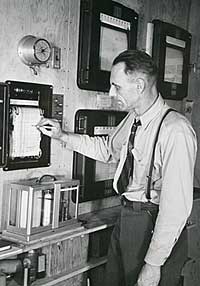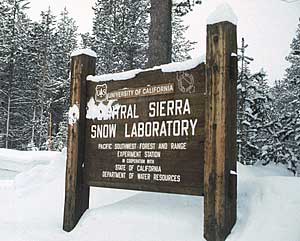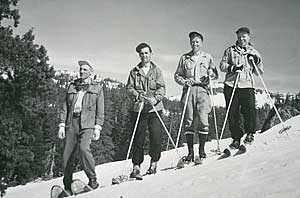 |
|
|
Follow Mark on Facebook for more stories |
||
|
Dr. Gerdel: Sierra Snow Man
The Sierra Nevada snowpack is without a doubt the Far West's most valuable natural resource — not for the economic benefit of winter sports, but because it supplies water runoff to California and western Nevada. The snowpack is a vital asset that provides high-quality melt-water to millions of people, as well as to industry, recreation, fisheries, agriculture and hydroelectric power generation.
Dr. Church made many important contributions to our understanding of the Sierra snowpack, but he was not a trained scientist and could not delve into the highly complex physics inherent in this massive frozen reservoir. The first stages of this critical research began during World War II when government physicist, Dr. Robert Gerdel, moved to Sacramento to establish the Central Sierra Snow Laboratory (CSSL) at Soda Springs, California, near Donner Pass. In the early 1940s, Dr. Gerdel was the lead physicist at the U.S. Weather Bureau and Technical Director of the government's newly-formed Cooperative Snow Investigations Research Program (CSIRP). One of his first assignments was to design and supervise the construction of three national snow laboratories in the mountainous West. After considerable research, Dr. Gerdel located the labs in central Oregon, at Donner Pass, and near Glacier Park, Montana. The sites reflect three distinct winter-precipitation regimes; mostly rain with some snow, mostly snow with some rain, and exclusively snow, respectively. Robert Gerdel was born in St. Louis, Missouri, on October 4, 1901, but grew up at Escanaba, Michigan. When he was 12 years old, a botched surgical procedure left him clinically deaf. A doctor had performed a successful tonsillectomy on the boy's kitchen table, but an infection soon set in that permanently damaged his ear canals. Losing your sense of hearing is a life-changing event, but Gerdel never let this physical handicap interfere with his plans to become a scientist. Although his high school principal tried to have him committed to the Michigan School for the Deaf, Gerdel successfully persuaded the administrator to give him a chance. He learned to lip-read, checked the lecture notes of his fellow students, and graduated with good grades. After high school, Gerdel attended Michigan State College of Agriculture and Applied Science (now Michigan State University) and graduated with a BS in Soil Physics and Chemistry. Not only was the coursework challenging, two of his college professors dropped him from their classes due to his lack of hearing. Gerdel went on to earn masters and doctorate degrees from Ohio State University.
At the Central Sierra Snow Lab, Dr. Gerdel pioneered the use of radioactive material to measure the water content and density of the snowpack. During the summer months, individual isotopes of radioactive zinc were placed in remote locations north of Donner Summit and a Geiger counter was suspended over each one. The Geiger counters measured the pulses or oscillations caused by gamma rays emitted by the radioisotope — the oscillations varied depending on the snowpack's density and water content. The radio-transmitted measurements gave the CSSL scientists constant, real -time data, a real breakthrough in the science of snow surveying.
The Donner Summit region of the Sierra proved to be a particularly well-suited area to launch the CSIRP. Long-term weather records for locations in western United States snow-zones are relatively rare, but Southern Pacific Transportation Company employees had begun measuring snowfall and snowpack at the railroad's Summit Station at Norden in 1878. Later, precipitation data from three different National Weather Service sites in the area maintained the continuity of the region's weather measurements. In addition to providing reliable conditions for studying the physics of a deep snowpack, the Sierra snow lab was critically important to the federal and state control of California's water supplies and flood control. The research conducted there allowed scientists and technicians to monitor snowfall and snow melt and to predict future needs of the State's water delivery system known as the Central Valleys Project (California aqueduct).
Dr. Gerdel's early efforts to investigate and improve our scientific understanding of the complexities of the vital Sierra snowpack laid the groundwork for a water management system that helped nourish and sustain the growth of California into an economic giant. |
|||||||||||||||||||||
|




